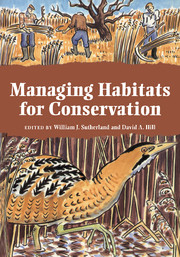Book contents
- Frontmatter
- Contents
- List of Contributors
- Acknowledgements
- 1 Introduction and principles of ecological management
- 2 Site management planning
- 3 Access
- 4 Coastal habitats
- 5 Rivers, canals and dykes
- 6 Waterbodies
- 7 Reedbeds, fens and acid bogs
- 8 Grasslands
- 9 Farmland
- 10 Lowland heathland
- 11 Upland moors and heaths
- 12 Woodland and scrub
- 13 Urban areas
- Some useful addresses
- Index of species by common names
- Subject index
8 - Grasslands
Published online by Cambridge University Press: 05 February 2015
- Frontmatter
- Contents
- List of Contributors
- Acknowledgements
- 1 Introduction and principles of ecological management
- 2 Site management planning
- 3 Access
- 4 Coastal habitats
- 5 Rivers, canals and dykes
- 6 Waterbodies
- 7 Reedbeds, fens and acid bogs
- 8 Grasslands
- 9 Farmland
- 10 Lowland heathland
- 11 Upland moors and heaths
- 12 Woodland and scrub
- 13 Urban areas
- Some useful addresses
- Index of species by common names
- Subject index
Summary
Introduction
The existence of virtually all grasslands in Britain is dependent on some process that prevents their succession to scrub and woodland. Before the influence of people, grasslands would largely have been restricted to areas where woody plants could not grow: on thin or infertile soils (e.g. sugar limestone in Upper Teesdale), where environmental conditions were harsh (as on high ground, cliffs or in very dry conditions such as in Breckland) or in some heavily disturbed areas. From neolithic times (4000–5000 years BP) onwards, clearance of woodland for farming would have allowed plants and animals from the existing grasslands to extend their range. Grazing, cutting and burning of the newly created agricultural grasslands arrested succession and in doing so, maintained suitable conditions for naturally occurring grassland plants and animals and a number of introduced species.
From the nineteenth century onwards, large losses of permanent grassland occurred as a result of the Enclosure Acts and agricultural development which allowed easier establishment of temporary grasslands. Since the 1940s agricultural intensification has accelerated this process. Most old grasslands have now either been ploughed up and converted to arable, or re-seeded with more agriculturally productive species. Of those remaining, the majority have been agriculturally improved using inorganic fertilizers and herbicides with the resultant loss of much of their wildlife interest. To be effective, most inorganic fertilisers have to be applied to free-draining and neutral soils. Drainage and neutralising of acidic soils using lime or marl has therefore usually accompanied their application and these have also usually proved deleterious to wildlife. More vigorous grass growth has allowed earlier mowing which, together with the increased cutting speed of modern mowing machines, has been particularly detrimental to ground-nesting birds.
- Type
- Chapter
- Information
- Managing Habitats for Conservation , pp. 197 - 229Publisher: Cambridge University PressPrint publication year: 1995
- 16
- Cited by

